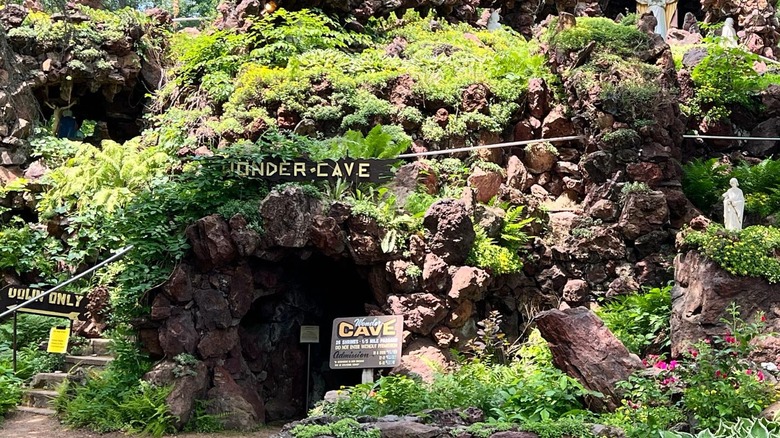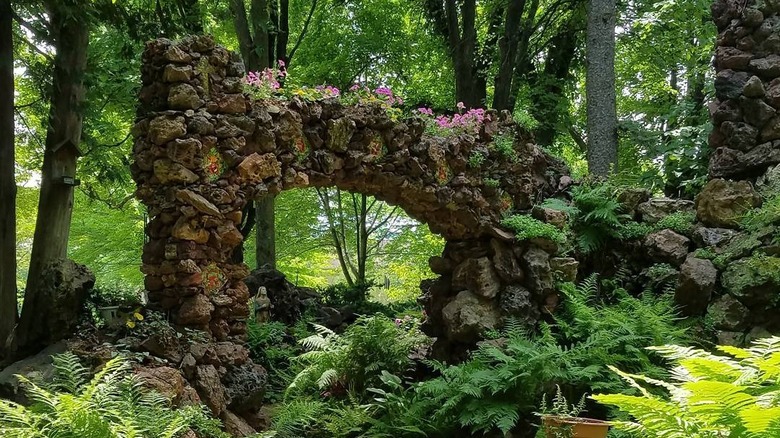A Unique Garden Art Park In Wisconsin Is A Serene, Quirky Sanctuary With Stunning Stoneworks
If you truly want to see something unique while traveling, you have to step away from the destinations that flood your social media feed. There's something special about visiting a place so unexpected that when you mention it at a dinner party, no one else has even heard of it. Wisconsin is full of these kinds of surprises. You might find yourself marveling at the gorgeous Holy Hill Basilica in Erin, Wisconsin, or indulging in farm-fresh cuisine in the hidden town of Viroqua. And then there's the Rudolph Grotto Gardens — an utterly baffling landmark in a tiny Wisconsin town that is as beautiful as it is holy.
Located in the village of Rudolph, home to just over 400 residents, the Rudolph Grotto Gardens are a blend of natural beauty and intricate stonework. Spanning 5 acres of flowers and trees, this site is part lush garden, part Catholic devotional masterpiece. But whether or not you're religious, this one-of-a-kind space is open for all to explore. Wander its winding paths, cross bridges, and admire the craftsmanship of its 26 hand-built shrines. You can also enjoy a picnic in the serene setting and learn more about its fascinating history at the on-site museum.
How a potato field became the divinely detailed Rudolph Grotto Gardens
The origins of the Rudolph Grotto Gardens date back to 1919 when Father Philip Wagner and his friend Edmund Rybicki began transforming a potato field into a sanctuary of stone and greenery. Father Wagner's inspiration came from his pilgrimage to the shrine of Saint Mary in Lourdes, France, where he vowed to build his own tribute to Mary if his health was restored. As his strength returned, so did his determination. While on a religious mission in Wisconsin, he began cultivating the land, eventually building shrines within the garden — despite his lack of masonry knowledge.
The most ambitious feature of the gardens, the Wonder Cave, took shape in 1935 and required 20 years of dedication. This one-fifth-mile grotto is covered in intricate symbols, proverbs, and biblical imagery. Though built with a religious purpose, the gardens have evolved into something much greater. Like the Camino de Santiago in Spain or Iowa's Grotto of the Redemption, the world's largest man-made grotto, this is a place of both spiritual and artistic wonder. As Tripadvisor visitor @AndrewFromMadison wrote, "these gardens are [a] work of art on their own, worth the visit from anyone."
Walking through the gardens, you'll find an array of hand-built shrines, including seven dedicated to the Seven Sorrows of Mary and 14 for the Fourteen Stations of the Cross. Each is adorned with shells, colored glass, and carefully arranged tiles. But it's not all about the stonework — nature is an equally integral part of the experience. A peaceful fish pond, gentle waterfall, and bird bath add to the garden's contemplative atmosphere, making it a place where beauty and reverence go hand in hand.
Planning your visit to the Rudolph Grotto Gardens
The Rudolph Grotto Gardens are free to explore, with a small fee to enter the Wonder Cave. At the entrance, you'll find a museum detailing the garden's history, as well as restrooms. In other parts of the gardens, there's a gift shop, a chapel, and a gazebo. The paths are accessible for visitors with mobility concerns, and wheelchairs are available on a first come, first served basis. The gardens are open seasonally from Memorial Day through the end of October.
Rudolph is located in central Wisconsin, about a 15-minute drive from Wisconsin Rapids. If you're flying in, the nearest major airport is Central Wisconsin Airport (CWA) in Mosinee, about 30 minutes away by car. From there, it's an easy drive through the scenic Wisconsin countryside to reach this treasure. And while you're in town, don't miss another local gem: the Dairy State Cheese Factory. After your garden stroll, stop in to sample some of Wisconsin's best cheese and learn about the time-honored art of cheesemaking. For such a small town, Rudolph boasts a truly monumental site that, with a little cheese on the side, feels like a Wisconsin rite of passage.


